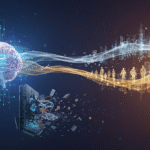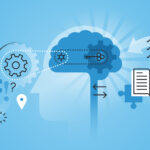Over the last few years, large language models (LLMs) have transformed how organizations think about artificial intelligence. Tools like ChatGPT, Claude, and Gemini demonstrate the raw power of statistical language training on massive corpora of text. But even as these models expand into multimodality, handling images, audio, and even code. Many experts believe we’ve only reached an intermediate stage on the path toward artificial general intelligence (AGI). The frontier beyond LLMs, they argue, lies in sensory-based AI: systems that learn by perceiving and interacting with the world through vision, hearing, and even touch.
This paradigm shift mirrors the way humans gain intelligence – not by memorizing libraries of text, but by physically engaging with our environment. And while the ultimate goal of AGI remains speculative, sensory-based AI already shows profound potential for enterprise applications where real-world complexity resists purely symbolic or text-based reasoning.
The Limits of LLM-Centric Learning
LLMs operate by predicting the next word in a sequence of text, which makes them exceptional at capturing linguistic patterns, summarizing knowledge, and generating human-like responses. But they remain fundamentally limited in two ways.
First, their understanding is statistical rather than experiential. An LLM knows that the word “wet” often follows “rain,” but it does not actually feel the cold droplets of a downpour. This detachment from lived experience leaves them vulnerable to hallucinations and brittle when faced with unfamiliar contexts.
Second, LLMs lack grounding in the physical world. Human intelligence is deeply embodied; we learn what “heavy” means by lifting objects, not just by reading the word in a book. Without such grounding, LLMs can produce fluent but nonsensical answers when asked to reason about physics, causality, or mechanical processes.
Sensory AI: Learning Through Perception
Sensory-based AI aims to overcome these barriers by training models not just on words, but on raw sensory data: images, sounds, tactile feedback, and their interrelationships.
- Vision-oriented AI systems, already visible in self-driving cars and robotic arms, process video streams to learn spatial relationships, object permanence, and cause-and-effect through motion. For example, a vision-based model can learn that a ball rolling toward the edge of a table is likely to fall.
- Audio-based AI systems go beyond transcription, recognizing subtle emotional cues in tone, environmental context in background noise, and the acoustic signatures of machines or biological processes.
- Touch-enabled AI—still in early development—provides feedback loops critical for tasks like surgical robotics, quality control in manufacturing, or dexterous manipulation of fragile objects.
When combined, these modalities approximate the way human infants acquire intelligence: by watching, listening, touching, and experimenting in a feedback-rich environment. This grounding provides a more robust foundation for reasoning than language alone.
Why Experts See This as a Path Toward AGI
Many AI researchers argue that sensory-based learning is more likely than text-based prediction to unlock the generality we associate with human intelligence. The reasoning is simple: human cognition evolved from embodied perception. Long before we developed language, we survived by recognizing predators, tracking prey, and manipulating tools with our hands.
By exposing AI systems to the full spectrum of sensory data, we enable them to build causal models of the world instead of probabilistic linguistic shadows. These models may in turn support more flexible reasoning, transfer learning, and creativity across domains – the hallmarks of AGI.
Some visionaries even foresee an eventual progression toward artificial superintelligence (ASI), where such systems exceed human capabilities not only in abstract reasoning but in navigating and mastering the physical environment.
Practical Promise for Enterprise AI
Even if AGI remains a distant goal, sensory-based AI is already unlocking enterprise use cases that LLMs cannot address effectively on their own. Consider several domains:
- Manufacturing & Industrial Operations
Factories are sensory environments—full of noise, vibration, heat, and motion. AI systems equipped with computer vision and acoustic sensors can monitor machinery for early signs of failure, detect quality defects on assembly lines, or coordinate fleets of robots working side by side with humans. Unlike text-based analytics, these systems adapt to the physics of production environments. - Healthcare & Surgery
Robotic surgical systems enhanced with tactile sensors and computer vision can provide feedback loops critical for delicate procedures. Similarly, AI trained on multimodal patient data—including imaging, voice patterns, and even touch—can offer more holistic diagnostics than text-only systems. - Logistics & Warehousing
Autonomous forklifts and drones rely on sensory AI to navigate complex spaces, recognize obstacles, and manipulate packages. This grounding in physical reality allows them to operate with higher safety and efficiency than symbolic planners alone. - Energy & Utilities
AI that listens to the hum of turbines, watches for visual anomalies in pipelines, or feels vibrations in infrastructure can predict breakdowns before they occur. In high-risk environments, such predictive maintenance is not just cost-saving but life-saving. - Customer Experience & Retail
Audio-visual AI systems can interpret customers’ emotional states through tone of voice, facial expressions, or gestures, enabling more empathetic service. Retailers can also use vision-based systems to monitor foot traffic and optimize store layouts.
From Multimodal Models to Truly Embodied AI
We are already seeing steps in this direction with the rise of multimodal foundation models – systems trained simultaneously on text, images, video, and audio. These models can caption images, describe video clips, and answer questions about sounds. But true sensory-based AI goes further by integrating perception with action.
Imagine a warehouse robot that not only sees a shelf but also understands the weight and balance of boxes it lifts. Or a diagnostic AI that listens to a patient’s breathing, feels subtle vibrations through sensors, and cross-references findings with medical literature. Such systems move beyond perception toward embodied intelligence.
Challenges on the Road Ahead
Building sensory-based AI is not without its hurdles.
- Data complexity: Unlike text, sensory data is high-dimensional, continuous, and deeply contextual. Training models on terabytes of video or tactile input demands enormous storage and processing power.
- Hardware requirements: Vision and touch systems often require specialized sensors—cameras, LIDAR, haptic devices—that must be deployed and maintained in real environments.
- Safety and ethics: Embodied AI systems interact with the physical world, where mistakes can cause accidents, injuries, or worse. Ensuring reliability, explainability, and safe fail-states is critical.
- Integration: Enterprises must integrate sensory AI into legacy workflows, which can be costly and disruptive without careful planning.
Despite these challenges, the competitive advantage of sensory AI will push industries to experiment and adopt. As with LLMs, early adopters stand to gain most.
A Complement, Not a Replacement
It’s important to recognize that sensory-based AI will not replace LLMs but rather complement them. Language remains the glue of human collaboration, and LLMs excel at knowledge retrieval, documentation, and communication. The future likely lies in hybrid systems where sensory AI perceives and acts, while language models explain, summarize, and interface with humans.
For enterprises, this means preparing for a layered AI ecosystem. Imagine a factory where robots diagnose machine health through vibration sensing, then generate maintenance reports using an LLM interface. Or a hospital where diagnostic AI listens to heart sounds, analyzes imaging, and then provides doctors with a natural-language summary of its findings.
The Future of AI Is Embodied
The excitement around LLMs is justified—they’ve changed the way we work and communicate. But if history is a guide, they are not the end of the AI story. Just as human intelligence is rooted in sight, sound, and touch, the next generation of AI will be grounded in sensory interaction with the world.
Whether or not this path leads directly to AGI or ASI, it promises to make AI far more useful in the messy, physical complexity of real-world environments. For enterprises facing challenges where physics, machinery, and human factors collide, sensory-based AI may soon become not a curiosity but a necessity.
In short, the future of AI will not only speak and write—it will see, hear, and feel. And that, more than eloquent text, may be what makes it truly intelligent.




